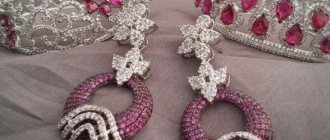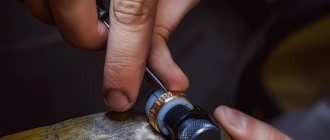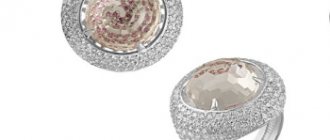The production of jewelry in Russia and throughout the world has become widespread. In order for products to have an impeccable appearance and high quality, it is important to take into account the features of the technological process. It, in turn, acts as the most important factor in shaping the strength and reliability of products. As part of its production, a whole cycle is carried out: from the acquisition of raw materials to final processing.
All technological processes observed during the production of jewelry can be basic and finishing.
The first group includes:
- punching;
- casting;
- fuse;
- annealing;
- rolling;
- getting rid of fat;
- soldering;
- drawing;
- washing;
- drying.
As for finishing operations, they can traditionally be presented as follows:
- chip;
- diamond type processing;
- softening;
- slicing;
- cutting;
- grinding/polishing;
- matting.
The range of finishing work carried out depends on the specific type of decoration
Casting
Making jewelry to order, as well as its mass production, involves the use of casting techniques. It involves the use of several dozen models simultaneously, which are assembled together and soldered to one base. As a result, a so-called “jewelry tree” is formed, which is subsequently shaped into clay and baked.
In order for the jewelry casting technique to be carried out efficiently, it is necessary that the clay dries evenly and that there are no cracks. An important role is also played by the flow of wax in full; this approach will allow you to obtain a form with voids. After this, the alloy is mixed and sent to the mold. All that remains is to cool this mass and remove the clay, taking out the finished “Christmas tree”.
At the next step, the work is carried out by jewelry assemblers. The technology makes it possible to produce products that contain several parts at the same time. It is precisely the assembly specialists who are engaged in fastening them together. The parts are assembled into one whole, and the rings are adjusted to the required size.
Features of jewelry casting
This direction correlates with the technologies for making jewelry in Ancient Egypt, as it has much in common with them. The manufacturing process has remained virtually unchanged since that time, and modern craftsmen actively use the technologies of their ancestors and innovative high-precision equipment.
It is worth noting that before installing the stone into the product, the workpiece is first subjected to grinding and polishing. In the first case, the profile is leveled, in the second, a shine effect is created.
Tumbling is a procedure involving a combination of grinding and polishing. Products are processed by first mixing in a drum with abrasive, the composition of which can be variable. When using this technique, the quality of the product is lower than when using grinding and polishing. However, the technique is fast and accessible.
Many mass-produced jewelry are processed exclusively using this technology.
Casting using inexpensive stones
This technique is used in making jewelry from silver and gold. It is worth noting that not every model is suitable for its use. The stones are inserted directly into the waxes during the process of creating a jewelry tree. After the mold is fired in clay conditions, the stones are stored inside. After pouring the metal, the inserts are immediately fixed. Next, the product enters the tumbling drum and is considered ready. Of course, in this case there is a fairly large percentage of defects, but production is considered to be as cheap as possible.
Jewelry factories and jewelry manufacturing enterprises
Jewelry factories are jewelry industry enterprises that produce products using artistic processing technologies from precious metals, stones and other materials, called jewelry.
The main raw materials for jewelry production are precious metals (gold, silver, platinum and platinum group metals - palladium, ruthenium, rhodium, osmium, iridium) and precious stones (diamond, ruby, emerald, sapphire). In addition, non-ferrous metals and their alloys, semi-precious, synthetic, ornamental stones, mother-of-pearl, glass, amber, enamel, bone, horn, and plastics can be used as raw materials for products.
Jewelry factories produce the following groups of products:
- personal jewelry - the main group of products, varied in types and styles, represented by rings, brooches, earrings, beads, bracelets, pendants, necklaces, medallions, chains;
- toiletry items (mirrors, perfume bottles, powder compacts, tie clips, cufflinks, hat pins);
- smoking accessories (cigarette holders, cigarette cases, snuff boxes, cigarette holders);
- products for table setting, represented by cutlery and teaware (spoons, knives, forks, glasses, shot glasses, glasses, wine decanters, teapots, coffee pots, glass holders, cups, saucers, napkin rings, salt shakers, pepper shakers);
- products used in interior design (vases, figurines, caskets, wall decorations);
- writing instruments;
- accessories for watches: wristwatches (bracelets and belts) and pocket watches (chalets, belts, side chains);
- souvenirs (keychains, badges).
According to the production method, jewelry is distinguished:
- individual production (handmade, with minimal use of equipment);
- mass production (using machining and precision investment casting).
The technological process in jewelry production is presented:
- procurement of materials (forming a master alloy, melting it, followed by rolling, drawing, forging, cutting);
- creating product forms (using stamping, assembly of parts, soldering, lost wax casting);
- filigree work and finishing operations (tumbling, sandblasting, brushing, grinding, polishing);
- decoration (using gilding, silvering, oxidation, anodizing, engraving, blackening, applying artistic enamel, inlaying, embossing);
- fixing the stones.
Modern jewelry production is mainly represented by the same technological processes as metallurgical and metalworking production. Jewelry factories are introducing computer technologies (for example, 3D modeling of jewelry) and high-tech operations (the use of centrifugal wax casting molds, mechanized soldering in ovens with a protective atmosphere, diamond cutting, electrochemical polishing, high-gloss gold galvanizing, ultrasonic processing of precious stones ).
Despite the fact that Russia is one of the largest producers of platinum and platinoids, most jewelry factories are not equipped with the necessary equipment for the production of platinum products. Their main range consists of products made of gold and silver, the demand for which is traditionally high in Russia.
The appearance of the first jewelry workshops in Russia dates back to the reign of Peter I. By his decree, the first Russian cutting factory was opened in Peterhof in 1725, and a grinding factory in Yekaterinburg in 1726. The dawn of jewelry production in Russia came at the turn of the 19th – 20th centuries, when the works of the Faberge firm, founded in 1848 in St. Petersburg, were recognized throughout the world as a standard of quality and high art. Historically established centers of jewelry production in Russia are Moscow, St. Petersburg, Kostroma, Yekaterinburg.
Setting stones
If a product is made with stones, then a setting procedure is required. This issue is resolved by the master fixer, who, in turn, installs the stones in the grooves and seals them to prevent them from falling out.
Practice shows that many stones are very fragile and cannot withstand loads during the setting process. This means that chips appear on them. If we are talking about inexpensive cubic zirconia, there is no problem. But in the case of diamonds, such nuances are unacceptable.
Handmade jewelry making is quite common, however, today automated processes are popular . The more efficiently each step is performed, the better the quality of the finished product is considered. Accordingly, the higher its cost.
How to launch your own jewelry brand The Village learned how to start a jewelry business
Irina Burtseva: “Shopping centers are very different, have their own characteristics and attract different audiences. Some are more fashionable, others are for families, others are for youth, and so on. This must be taken into account. It is worth spending a lot of time in a shopping center at different times of the day and days of the week to see with your own eyes who its visitors are and how many there are. It is useful to ask salespeople at other stores. Of course, according to the instructions, they should not tell you anything, but you can get general information. There are official ratings of the popularity of shopping centers, and traffic information and reviews are available on the Internet.
Evaluate shopping centers from the point of view of your capabilities. What contacts do you have? How much are you willing to pay for rent? Knowing the name and contacts of a specific employee, whom you can contact if something happens, always adds points. Shopping centers hold events for potential tenants, where you can meet the right people in person. A number of shopping centers rent out their space through agencies.
Shopping centers are reluctant to take on new unknown brands, because they are interested in stable tenants for a long period. But if you feel strong, your concept is solid and you have a margin of safety to pay the rent in case of weak sales, then it’s worth a try. You will need a cool presentation, with a lot of photos and comprehensive information about your company: concept, pricing policy, sales channels, publications, team. Following the presentation, the shopping center may request a visualization of your store or kiosk - this should be prepared in advance. All materials must be prepared by professionals.
Jewelry displays should be a magnet for shoppers: inspire them to buy, but not distract from the jewelry with an ostentatious design. Typically, jewelry stores are located in a small area. This means that every square centimeter of space counts. It is important to properly organize both the storage area and the display cases so that the maximum amount of goods and all the necessary things can fit. At the same time, all the equipment of the future store will be subject to daily active use, which means, in addition to aesthetics and ergonomics, it is necessary to take care of the durability of all elements. And of course, we must not forget about security: reliable locks, safes, a video surveillance system and an alarm system are required.
Silver jewelry is considered a high-margin product, and with successful developments, namely good sales from the start, as we had, the store pays for itself in 4-6 months, depending on the location, season and other factors.
First sales of WANNA?BE! took place through social networks, and we also promoted through them, then followed markets, and then a corner in the store of young Russian designers. My ambitions forced me to move forward, so I chose retail sales as the main direction for development. From the very beginning I knew what my “island” would look like. I came up with the idea of making it in the shape of a huge diamond. Fortunately, the management of Afimall liked my idea, and the store was opened before the New Year in 2013. Since then, the same diamonds have appeared in Aviapark and Metropolis. I built my first kiosk without any experience, so I had to modify it several times. But in the last opened island WANNA?BE! In the Metropolis shopping center, all details were taken into account. I found the contractor through recommendations from friends, just like every previous time. We finally broke the tradition of calling electricians and carpenters the next day after opening to finish and repair something.”
Automated technologies
Knitting chains and bracelets by hand is an extremely routine task. The jeweler is required to work with gold wire of the required thickness, as well as subsequent cutting of links and weaving. This means that the work will cost even more than the cost of the raw materials. Automated production allows the use of special machines that are manufactured for different types of work.
With their help, it will be easy to reduce the cost of a machine hour and speed up the process
Features of jewelry polishing
With its help, as already noted, you can get a mirror shine and maximum reflection. This process is carried out on a specialized machine, which involves the use of pastes and circles made of leather, felt, and cotton material.
Considering that jewelry is made not only by hand by highly skilled craftsmen, but also using automated stamping systems, when purchasing, pay attention to such details as the cleanliness of the work performed, how strong the clasps, links, and inserts are.










